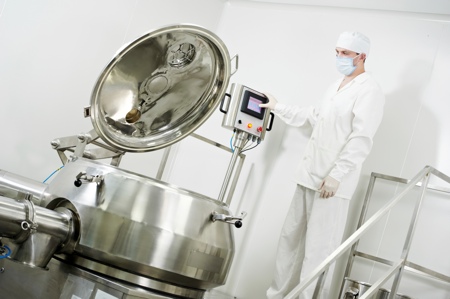The last five years have seen many significant changes in pharmaceutical manufacturing: a continuing global recession, the patent cliff, the end of the blockbuster business model, the growth of the biopharmaceutical sector, the increasing importance of outsourcing and the expanding influence of the emerging economies, to name but a few.
According to William Botha, a trainer and mentor in lean leadership and manufacturing, companies should be asking themselves: ‘Where do we want to be in 10–15 years’ time?’ He identifies a divergence in pharma business models – one moving towards the complex and the niche, the other towards the commodity and low-margin product. ‘I don't think they belong in the same space,’ he says. ‘The decision on whether or how to move regarding the core business must be driven by economics.’
Big Pharma cannot survive on drugs that are high treatment dollars per capita
Girish Malhotra, who has more than 40 years’ experience in process technology development, agrees that the brand pharma business model has to change in the long term. The current focus of addressing orphan and rare diseases might be a short-term rescue until governments and healthcare programmes and providers demand reasonable competitive prices, but patients cannot subsidise inefficiencies for ever, he warns.
‘Due to the lack of breakthrough NCEs, brands will try to extend their reach through combination or biotech drugs; however, this effort will take more than five years to commercialise,’ he suggests. ‘Big Pharma cannot survive on drugs that are high treatment dollars per capita. They need drugs that are low dollars per capita and have a large customer base.’
ADCs an area of particular promise
One area of particular promise is antibody drug conjugates, which are expected to account for more than 10% of revenues for the total antibody market and will be worth approximately US$10bn by 2023. The number of IND submissions is also predicted to rise by 50% over the next five years. Vijay Shah, Executive Director and Chief Operating Officer of Piramal Enterprises, is one who believes their time has come, owing to their targeted delivery and hence reduced side-effects in cancer treatment.
With the recent FDA approvals of Adcetris (brentuximab vedotin) and Kadcyla (ado-trastuzumab emtansine), ADCs represent a growing area in oncology and have huge potential, he says. Current targets include difficult-to-treat cancers such as triple-negative breast cancer, gastric tumours, small-cell lung cancer, melanoma and pancreatic cancer.
The rapid growth in ADC technology is being driven by the flexibility of the platform
Shah forecasts that by 2020, the pharma and biotech industries will invest more heavily in the ADC market. Now that the therapeutic potential of this class of drugs has been recognised, most major pharmaceutical firms are either already established in the area or looking to get involved. The rapid growth in ADC technology is being driven by the flexibility of the platform. And their potential is not just limited to oncology, they are also being investigated for indications such as inflammation.
The full potential of the ADC market will become clearer in the next few years, as more products progress through late-stage clinical trials, says Shah.
However, the development and manufacture of ADCs can be a challenge, as it requires the ability to handle both biologics and highly potent small molecule toxins. This combination of capabilities is not often found in the same organisation, and only a relatively small number of contract manufacturing organisations (CMOs) cover the ADC manufacturing space.
Regulatory challenges
Historically, regulators required products such as specific antibiotics, hormones, cytotoxics and certain highly active drugs, to be manufactured in dedicated or segregated self-contained facilities, points out Dr Mark Carver, Senior VP Research & Development and Innovation at Fujifilm Diosynth Biotechnologies.
Other products can, in principle, be manufactured in multi-product facilities, provided that stringent cleaning processes are put in place between the manufacture of different products. But there has long been discussion about the need to apply a clearer definition of what can be produced in multi-product facilities, and developing a better science-based risk assessment framework.
EMA’s draft Guideline on Setting Health Based Exposure Limits for Use in Risk Identification in the Manufacture of different Medicinal Products in shared Facilities is a significant step towards establishing such a framework. However, if the guideline is adopted in its current form, Carver suggests that it could impose ‘significant new constraints on how early phase Investigational Medicinal Product (IMPs), particularly biologics, are manufactured’ and could require that each IMP be manufactured in a dedicated facility.
There is a general view that biologics are not, as a class, toxic
In 2010, the International Society for Pharmaceutical Engineering (ISPE) published its Baseline* Guide: Risk-Based Manufacture of Pharmaceutical Products, which recommended the adoption of the health-based concepts of toxicologically determined Acceptable Daily Exposure (ADE) and Operational Exposure Limits (OEL) to control cross contamination exposure to both patients and operators. In 2012 the draft EMA guideline recommended use of Permitted Daily Exposure (PDE) or the Threshold of Toxicological Concern (TCC) parameters when considering the production of different medicinal products in shared facilities.
But the ADE/PDE approach is problematic when used with some early phase IMPs, particularly biologics, as a number of parameters are frequently not known when decisions to proceed to manufacture are taken, says Carver. There is a general view that biologics are not, as a class, toxic. Studies have supported this view by demonstrating that they have a significantly lower failure rate than small molecule pharmaceuticals in safety trials.
The use of health-based exposure limits does not differentiate between concepts of toxicity and potency and the recognition that, while proteins may not be toxic many of them are highly potent, is leading towards a change of view about how such molecules are manufactured and handled.
The use of health-based exposure limits does not differentiate between concepts of toxicity and potency
Carver proposes that the approach required by the draft EMA guideline is applied where there is sufficient data to derive a PDE or ADE, but where such data is not available, a ‘banding’ approach, which is considered similar to that used for deriving Occupational Exposure Bands (OEBs), should be taken. Assignment to certain bands could be set automatically to require use of fully dedicated facilities.
Tied in with this is the fact that the pharma industry is facing increased scrutiny by regulatory authorities globally, and in particular the US FDA, which is establishing progressively higher standards of safety and quality.
cGMP compliance failures
Both Big Pharma and small companies are still failing in terms of cGMP compliance, says Dilip Shah, CEO of Vision Consulting Group, and the number of drug recalls, market withdrawals and safety alerts reported over the last three years indicates that while many instances of non-compliance are inadvertent, some are deliberate.
This view is backed up by independent consultant and academic Prabir Basu. He believes that GMP manufacturing must be done consistently throughout a facility. ‘It is not possible to have cGMP and non-cGMP cultures existing side by side in the same facility as eventually people will take shortcuts and sacrifice cGMP,’ he says.
Another major concern relates to the rapid increase in the detection of foreign particles in drugs. This is not a deliberate violation, but needs to be addressed, with the help of guidance from the regulators and experts. Many other issues could be similarly resolved, says Dilip Shah, but it will require a change in how the role of drug inspectors is perceived – less as a forensic auditor, and more as a guide – to help ensure the common goal of safe, effective and quality medicines.
Compliance and product quality are correlated but involve different mindsets, according to Botha. ‘Continuous quality improvement requires workers who are inspired and empowered to find new ways to improve the way things are done every day. Compliance deals with check boxes, managing audits, offering best practices for submissions, etc.’
This view is echoed by Bikash Chatterjee, President and Chief Technical Officer of Pharmatech Associates. The current state of disrepair among ethical pharma will continue into 2014, he says, although pressure from the escalating problems created by drug shortages will complicate a clear message to industry from the FDA.
‘The inability to link investing in process and product understanding as a foundation for product safety and efficacy, as opposed to a compliance-driven activity will still be an impediment to broader adoption of this new quality paradigm within and outside the US,’ he states.
Most pharma companies are trying to do the right thing but have much more to manage than in the past, points out Sam Venugopal, Director, Healthcare at Pricewaterhouse-Coopers. It is important to automate quality systems and to be less dependent on manual, paper-based systems, he believes. ‘Understanding the impact of the human element is critical to ensuring quality and there is a need for more accountability from the top down.’

Ingredients are the biggest source of challenges and will remain so
Ingredients are pharma’s biggest source of challenges and will remain so. Most companies are still getting ingredients that are not being inspected or are being minimally inspected and this is one of the greatest unknowns for the industry, according to Basu. ‘It is my understanding that suppliers in some countries will mix excipients from different sources and then export them. If one or more of the sources were adulterated or substandard there would be no way to know.’
‘We have to ensure that the product is of the right quality before it is used and we need to have complete traceability for the origin of the ingredients. Clearly the responsibility has to be on the manufacturers.’
There is a need for more inspection of offshore facilities and more severe penalties for violations
Although India and China have only pockets of cGMP manufacturing, Basu acknowledges that they have been manufacturing to cGMP standards for a relatively short time so it is unreasonable to expect a very sophisticated level of compliance. In general he believes that there is a need for more inspection of offshore facilities and more severe penalties for violations. ‘European and US pharma companies should do some industry-wide bench-marking to set baseline requirements and rate current suppliers,’ he says.
Some collaboration and co-operation among regulatory authorities will help cut development costs and reduce duplication, adds Carver, but large-scale integration of the global regulatory landscape is unlikely to be comprehensive over the next five years.
Emil Cuirczak, Principal at Doramax Consulting, also expects to see more collaboration between the FDA and the EMA and a move to establish a “United Nations of Regulatory Agencies”. ‘Progress on harmonisation may seem slow at times, but remember that 15 years ago we had different specifications for different countries, whereas now we have ICH specifications for product release.’
Most generics companies will merge and the “mom and pop” type operations won’t survive
One factor that could boost this process is the consolidation of the generics sector – a smaller number of larger generics companies would mean fewer facilities for regulators to inspect, he suggests. ‘I believe that most generics companies will merge and the “mom and pop” type operations won’t survive so we'll have a smaller number of larger companies.’
It is not just regulators who should increase their collaboration; many companies should improve their internal communications, particularly when it comes to sharing best practice across multiple sites. Venugopal believes that the ‘silo mentality’ – e.g. separating manufacturing from R&D – is starting to break down, especially in larger companies that have the tools and resources required to invest in collaborative platforms, social networking and knowledge management and information sharing. These technologies could spread to smaller companies, he says.
‘Increased collaboration and knowledge stems from increased ability to handle data. We can now gather and analyse knowledge to an unprecedented degree. Pharma’s age of big data is still in its early stages but some companies already have the right outlook and many of the required tools in place,’ he suggests.
Chatterjee expresses a similar view: ‘The activities between invention and execution will continue to contract as industry looks for ways to compress the R&D timeline and increase the potential success rate for products in development.’
Increased collaboration and knowledge stems from increased ability to handle data
Improved information retrieving and sharing will make it potentially easier to turn QbD into a reality, Venugopal hopes. ‘Some of the initial industry momentum may have been lost,’ he suggests, ‘and we are still hearing the same things we heard about QbD and PAT a decade ago. More work is needed to convince industry that the FDA and the regulators are truly behind the principles.’
Ciurczak is particularly excited about the potential for continuous processing and the move away from large batches. There are, he says, automated systems to guarantee mixing that operate continuously and will allow companies to speed up pre-pilot scale work in design of experiments, technology transfer and the determination of the design space.
‘These systems will eliminate some of the problems seen with traditional methods in the past when moving from lab scale batches into small manufacturing scale,’ he says. ‘Being able to make small, facile lots will lend itself very well to doing design of experiments and design space work required for QbD.
‘With the newer systems you will be able to do DOEs in days rather than weeks or months. In the future we are less likely to hear complaints that DOE and QbD “ties up equipment” and “costs too much”.’

Compliance and product quality are correlated but involve different mindsets
According to Malhotra, regulations rather than technology have been the focus and companies have opted to meet the regulations to deliver the desired quality product rather than have the best technology that will deliver quality. ‘This approach and methodology does not work in any other industry,’ he asserts. ‘In pharma this works because the industry has been able to pass the inefficiency costs to its customers.
‘Pharma has justified pricing to recoup R&D money for new drugs. That is fine but there has been no effort to minimise and/or eliminate inefficient practices in the current business model.
‘There are multiple opportunities to lower the costs if manufacturers become “process centric”. PAT and QbD will become a natural part of the process; costs to incorporate them are significantly lower if done from the process development stage rather than after the fact,’ he emphasises.
There are multiple opportunities to lower the costs if manufacturers become “process centric”
Growing numbers of pharma companies are outsourcing operations as well as materials, Venugopal says. He predicts that there will be more contracting up and down the supply chain, but efforts will become more strategic, with companies studying the costs versus benefits closely. They will also be outsourcing more in the early stages and developing multiple compounds with a single partner.
In countries such as the US where venture capital funding for pharma products is still very tight, more start-up companies have no choice but to use a highly qualified CMO to move a molecule through the development lifecycle, says Chatterjee. But the nature of the support is often limited to assistance with equipment and providing resources for supporting development batches.
However, since most strategies today include some component of product introduction outside the US, he believes the role of the CMO will continue to expand to include key tactical elements related to understanding the regulatory and licensing requirements for introducing products into new markets such as China.
‘Outsourcing is here to stay: the economics are just too favourable and too hard to ignore,’ concludes Venugopal.
The CPhI PharmaEvolution Annual Industry Report (Parts I and II) is available to download free of charge from www.pharmaevolution.com.

